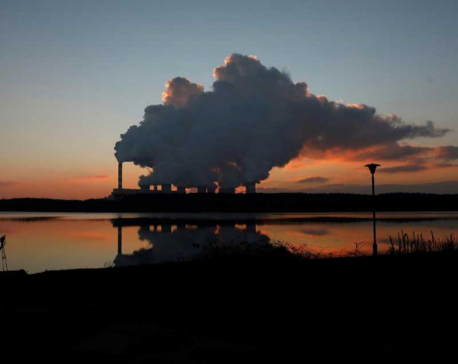
OR
Editorial
Rising Carbon Emissions, Nepal and Its Neighbors
Published On: March 10, 2023 07:45 AM NPT By: Republica | @RepublicaNepal

The International Energy Agency (IEA) released a report last week indicating that carbon dioxide (CO2) emissions in 2022 were the highest since 1900. The primary source of these emissions is the combustion of fossil fuels, which are responsible for the rising temperatures on Earth. The increase in CO2 emissions is a significant cause for concern. According to the report released on March 2, energy-related CO2 emissions rose by 0.9 percent in 2022. Although the rise in emissions last year was far smaller than the exceptional jump of over 6 percent in 2021, emissions still remain on an unsustainable growth trajectory.
According to recent data, the CO2 emissions into the atmosphere reached a staggering 321 million tons in 2022. The rising levels of CO2 emissions are a significant cause for concern, as the carbon released into the atmosphere remains there for hundreds of years. Scientists explain that as CO2 absorbs heat from sunlight, it raises the temperature of the atmosphere, leading to global warming. The Earth is currently 1.1 degrees Celsius warmer than before the first industrial revolution. To address this issue, countries signed the Paris Agreement on climate change, committing to limiting global warming to 1.5 to 2 degrees Celsius by the end of this century. However, recent estimates suggest that temperatures may rise by over 2.5 degrees Celsius, which is a significant deviation from the agreed-upon target.
It has been reported that the number of climate-related natural disasters has increased significantly due to rising temperatures. These natural calamities, such as floods, landslides, heatwaves, and wildfires, cause extensive damage to life and property every year. The IEA report highlights that in 2022, the burning of coal to produce electricity increased as hydropower projects were affected by receding water levels in rivers caused by droughts. Furthermore, electricity demand rose significantly due to unexpected heat waves in several parts of the world. As a result, energy-related greenhouse gas emissions increased by one percent in 2022, according to the IEA report. It is widely acknowledged that greenhouse gases are one of the leading causes of global warming.
The report highlights that CO2 emissions from coal increased by 1.6% due to the ongoing global energy crisis, which has triggered a wave of gas-to-coal switching in Asia and, to a lesser extent, in Europe. Although the increase in coal emissions was only one-quarter of the rise seen in 2021, it still exceeded the average growth rate observed over the last decade. Similarly, CO2 emissions from oil increased by 2.5% but remained below pre-pandemic levels. The report notes that roughly half of the year-on-year increase in oil emissions came from aviation, as air travel rebounded from the pandemic lows. Additionally, the report indicates that the increase in coal emissions outweighed the 1.6% decline in emissions from natural gas, as supply remained tight following Russia's invasion of Ukraine, and European businesses and citizens worked to reduce their gas usage.
It is evident that carbon emissions in one part of the world have a significant impact on the environment, climate, and development in another part. The economic growth achieved worldwide in the last six decades and the subsequent increase in population have come at a price- environmental degradation. Since 1960, the average per capita GDP has tripled; however, CO2 emissions, which are considered the primary cause of rising temperatures, have quadrupled over the same period. A significant portion of this increase, about two-thirds, has occurred in the last three decades.
The United States, China, and India are among the countries with the highest carbon emissions globally. These three nations combined contribute to nearly 50% of the total carbon emissions worldwide. The top 20 countries in terms of carbon emissions are responsible for 80% of the world's total carbon emissions. China, Nepal's northern neighbor, has made significant strides in terms of economic progress, poverty alleviation, and integration into the world supply system. However, these achievements have come at a cost of significantly increasing carbon emissions.
Nepal, known as the 'yam between two boulders', is located between the two largest carbon-emitting countries in the world, China and India. India, in particular, is the third-largest carbon emitter globally. As a result, Nepal is directly impacted by the high levels of carbon emissions in its neighboring countries. The consequences include melting glaciers, the risk of glacial lake outburst floods, the transformation of once snow-capped mountains into barren landscapes, and the increasing air pollution in Nepal. It is imperative that Nepal's larger neighbors take this issue seriously and consider compensating Nepal for its losses. Moreover, the situation requires urgent regional and global cooperation to address this issue.
You May Like This

COP28 pledges so far not enough to limit warming to 1.5C: IEA
DUBAI, Dec 10: A raft of new pledges announced at the COP28 climate summit - from tripling renewables to reining... Read More...

Pressure mounts to bury carbon emissions, but who will pay?
LONDON, Nov 29: When countries gather on Sunday to hammer out how they will enact pledges to cut carbon emissions,... Read More...







Just In
- Over 100,000 tourists visit Nepal monthly on average
- Sudurpaschim CM Sodari to seek vote of confidence tomorrow
- Incidents of forest fire on the rise with 165 incidents reported so far this year
- Newly-appointed Vice Chancellors call on PM Dahal
- West Indies 'A' clinches T20 Series title against Nepal
- Tibet to purchase haylage and animal fodder from Nepal
- Govt effortful for boosting investment in IT sector: Minister Sharma
- Embassy of Nepal in Canada advises students to travel with complete information and accommodation arrangements











Leave A Comment